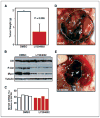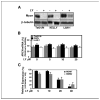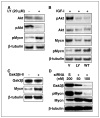Inhibition of phosphatidylinositol 3-kinase destabilizes Mycn protein and blocks malignant progression in neuroblastoma
- PMID: 16912192
- PMCID: PMC2924674
- DOI: 10.1158/0008-5472.CAN-05-2769
Inhibition of phosphatidylinositol 3-kinase destabilizes Mycn protein and blocks malignant progression in neuroblastoma
Erratum in
- Cancer Res. 2006 Oct 15;66(20):10227
-
Editor's Note: Inhibition of Phosphatidylinositol 3-Kinase Destabilizes Mycn Protein and Blocks Malignant Progression in Neuroblastoma.Cancer Res. 2024 Oct 1;84(19):3311. doi: 10.1158/0008-5472.CAN-24-2888. Cancer Res. 2024. PMID: 39350668 No abstract available.
Abstract
Amplification of MYCN occurs commonly in neuroblastoma. We report that phosphatidylinositol 3-kinase (PI3K) inhibition in murine neuroblastoma (driven by a tyrosine hydroxylase-MYCN transgene) led to decreased tumor mass and decreased levels of Mycn protein without affecting levels of MYCN mRNA. Consistent with these observations, PI3K inhibition in MYCN-amplified human neuroblastoma cell lines resulted in decreased levels of Mycn protein without affecting levels of MYCN mRNA and caused decreased proliferation and increased apoptosis. To clarify the importance of Mycn as a target of broad-spectrum PI3K inhibitors, we transduced wild-type N-myc and N-myc mutants lacking glycogen synthase kinase 3beta phosphorylation sites into human neuroblastoma cells with no endogenous expression of myc. In contrast to wild-type N-myc, the phosphorylation-defective mutant proteins were stabilized and were resistant to the antiproliferative effects of PI3K inhibition. Our results show the importance of Mycn as a therapeutic target in established tumors in vivo, offer a mechanistic rationale to test PI3K inhibitors in MYCN-amplified neuroblastoma, and represent a therapeutic approach applicable to a broad range of cancers in which transcription factors are stabilized through a PI3K-dependent mechanism.
Figures







Similar articles
-
Molecular rationale for the use of PI3K/AKT/mTOR pathway inhibitors in combination with crizotinib in ALK-mutated neuroblastoma.Oncotarget. 2014 Sep 30;5(18):8737-49. doi: 10.18632/oncotarget.2372. Oncotarget. 2014. PMID: 25228590 Free PMC article.
-
The MYCN oncoprotein as a drug development target.Cancer Lett. 2003 Jul 18;197(1-2):125-30. doi: 10.1016/s0304-3835(03)00096-x. Cancer Lett. 2003. PMID: 12880971 Review.
-
The aurora kinase inhibitor CCT137690 downregulates MYCN and sensitizes MYCN-amplified neuroblastoma in vivo.Mol Cancer Ther. 2011 Nov;10(11):2115-23. doi: 10.1158/1535-7163.MCT-11-0333. Epub 2011 Sep 1. Mol Cancer Ther. 2011. PMID: 21885865 Free PMC article.
-
Hsp90 inhibition increases p53 expression and destabilizes MYCN and MYC in neuroblastoma.Int J Oncol. 2011 Jan;38(1):105-12. Int J Oncol. 2011. PMID: 21109931 Free PMC article.
-
MDM2 as MYCN transcriptional target: implications for neuroblastoma pathogenesis.Cancer Lett. 2005 Oct 18;228(1-2):21-7. doi: 10.1016/j.canlet.2005.01.050. Cancer Lett. 2005. PMID: 15927364 Review.
Cited by
-
Pleiotropic role for MYCN in medulloblastoma.Genes Dev. 2010 May 15;24(10):1059-72. doi: 10.1101/gad.1907510. Genes Dev. 2010. PMID: 20478998 Free PMC article.
-
Polymeric nanomedicine for overcoming resistance mechanisms in hedgehog and Myc-amplified medulloblastoma.Biomaterials. 2021 Nov;278:121138. doi: 10.1016/j.biomaterials.2021.121138. Epub 2021 Sep 29. Biomaterials. 2021. PMID: 34634662 Free PMC article.
-
PHA-680626 Is an Effective Inhibitor of the Interaction between Aurora-A and N-Myc.Int J Mol Sci. 2021 Dec 4;22(23):13122. doi: 10.3390/ijms222313122. Int J Mol Sci. 2021. PMID: 34884931 Free PMC article.
-
Integrated Genomic Profiling and Drug Screening of Patient-Derived Cultures Identifies Individualized Copy Number-Dependent Susceptibilities Involving PI3K Pathway and 17q Genes in Neuroblastoma.Front Oncol. 2021 Oct 14;11:709525. doi: 10.3389/fonc.2021.709525. eCollection 2021. Front Oncol. 2021. PMID: 34722256 Free PMC article.
-
Intersectin 1 is required for neuroblastoma tumorigenesis.Oncogene. 2012 Nov 15;31(46):4828-34. doi: 10.1038/onc.2011.643. Epub 2012 Jan 23. Oncogene. 2012. PMID: 22266851 Free PMC article.
References
-
- Brodeur GM. Neuroblastoma: biological insights into a clinical enigma. Nat Rev Cancer. 2003;3:203–16. - PubMed
-
- Brodeur GM, Maris JM. Neuroblastoma. In: Pizzo PA, Poplack DG, editors. Principles and practice of pediatric oncology. 4. Philadelphia: J.B. Lippincott Company; 2002. pp. 895–938.
-
- DuBois SG, Kalika Y, Lukens JN, et al. Metastatic sites in stage IV and IVS neuroblastoma correlate with age, tumor biology, and survival. J Pediatr Hematol Oncol. 1999;21:181–9. - PubMed
-
- Norris MD, Bordow SB, Marshall GM, et al. Expression of the gene for multidrug-resistance-associated protein and outcome in patients with neuroblastoma. N Engl J Med. 1996;334:231–8. - PubMed
-
- Brodeur GM, Seeger RC, Schwab M, Varmus HE, Bishop JM. Amplification of N-myc sequences in primary human neuroblastomas: correlation with advanced disease stage. Prog Clin Biol Res. 1985;175:105–13. - PubMed
Publication types
MeSH terms
Substances
Grants and funding
LinkOut - more resources
Full Text Sources
Other Literature Sources
Medical
Molecular Biology Databases

